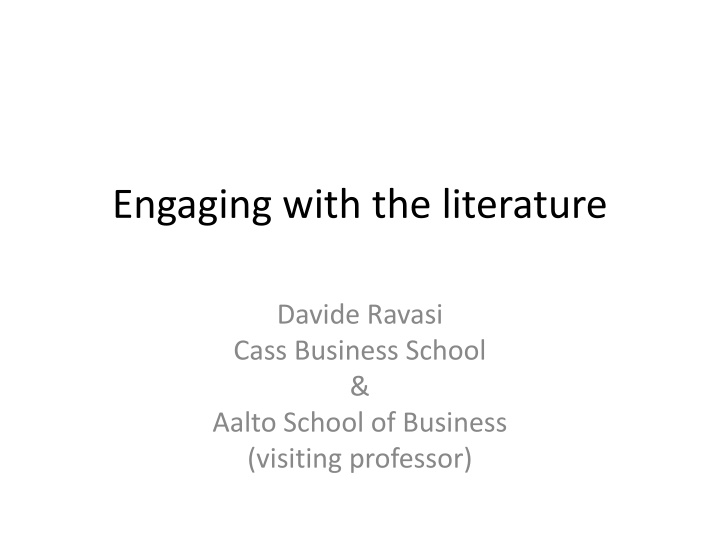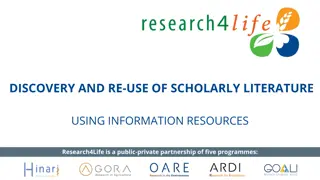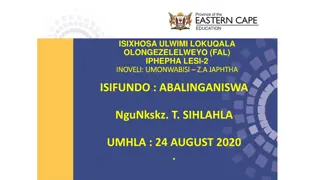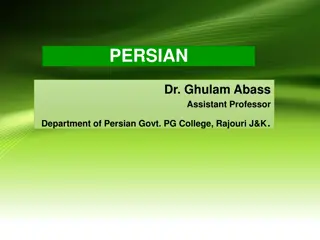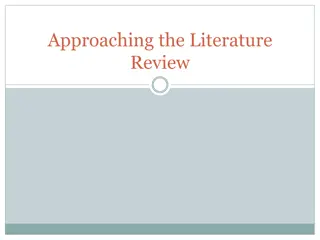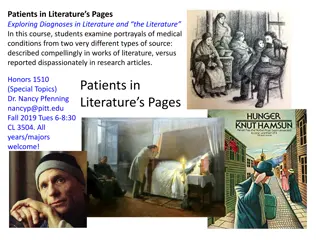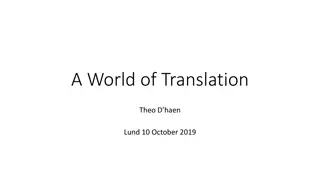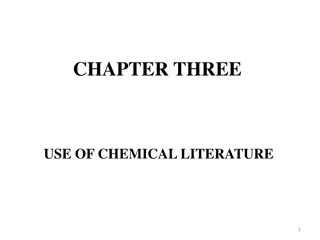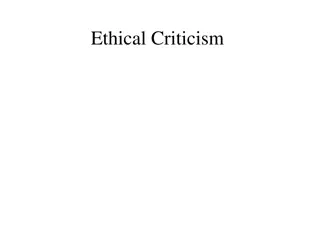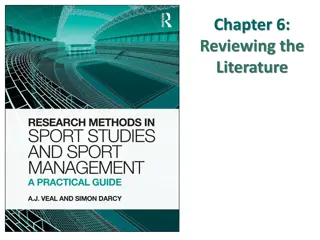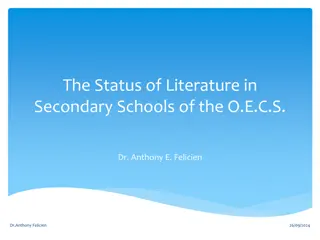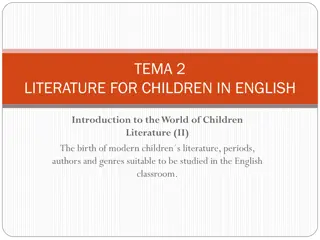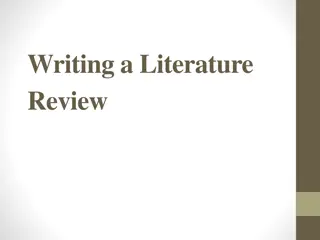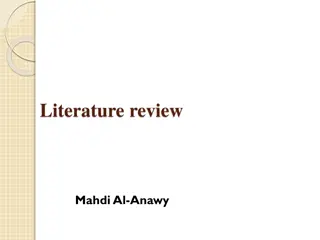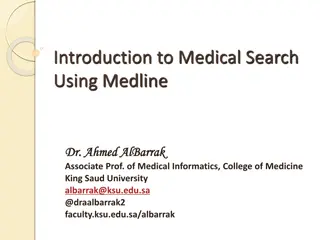Engaging with the literature
An exploration of the diverse enclaves within the field of organization studies, highlighting the challenges of integrating various perspectives and the socially constructed nature of scientific knowledge in administrative science. The discussion delves into the nuanced dynamics of scholarly writing and the criteria for theoretical contributions, shedding light on the intricacies of academic discourse and knowledge generation in a multidimensional landscape.
Download Presentation

Please find below an Image/Link to download the presentation.
The content on the website is provided AS IS for your information and personal use only. It may not be sold, licensed, or shared on other websites without obtaining consent from the author.If you encounter any issues during the download, it is possible that the publisher has removed the file from their server.
You are allowed to download the files provided on this website for personal or commercial use, subject to the condition that they are used lawfully. All files are the property of their respective owners.
The content on the website is provided AS IS for your information and personal use only. It may not be sold, licensed, or shared on other websites without obtaining consent from the author.
E N D
Presentation Transcript
Engaging with the literature Davide Ravasi Cass Business School & Aalto School of Business (visiting professor)
An insigthful view of the field The field of organization studies is a large, heterogeneous field involving numerous enclaves having distinct styles, orientation and beliefs. It is integrated neither by a shared theory, nor by a shared perspective, nor even by a shared tolerance for multiple perspectives. It retains substantial intellectual, geographic and linguistic parochialism, with separate enclaves persisting in their own worlds of discourse and forming a common field only by definition that overlooks diversity. James March, 2007
Administrative science as a socially constructed truth (Astley, 1985) Administrative science requires preliminary conceptual distinctions regarding the investigated phenomena (i.e what is an organization?) Unlike natural scientists, social scientists change the phenomena under investigation, which makes it difficult to develop objective scientific criteria Our knowledge of social facts is mediated by language, reflecting different world views (hence inherently biased), and intersubjectively constituted Researchers vastly diverge in background, interests, values and philosophies. Fragmentation: Multiple, competing paradigms (world views)
The social construction of scientific knowledge In administrative science, knowledge is generated in a rigorous process of intellectual scrutiny, which is, nevertheless, an act of social negotiation (Biased) gatekeepers (editors and reviewers) define what counts as important and valid Different observers tend to apply favored theoretical perspectives and methodological canons in a more or less exclusive manner. Adherence to biased and partial world views is usually rewarded
Papers are rejected because they lack theoretical contribution . But what passes as a theoretical contribution?
Whatever persuades the editor and the reviewers An idea becomes a contribution when it is constructed as important by the members of a scholarly community, relative to the accepted knowledge constituted by the field s written work (Locke & Golden-Biddle, 1997)
Scholarly writing as conversation (Huff, 1999) Scholarly work is rooted in lively exchanges of ideas ( conversations ) Many different conversations are taking place at the same time need to establish our location in the social space of scholarship: who may be interested in my research? who seems to share my world view ? who do I really want to talk to?
What makes a theory published and cited? Social similarity increases publications chances New approaches must be oriented towards the work of colleagues and useful in their research (or personal agenda) Theories become popular because of their interest value, rather than their truth value (Christensen- Szalanski & Beach, 1984) Need to relate to established frameworks to define the significance and meaning of research findings
What makes a theory interesting ?
Thats Interesting! (Davis, 1971) New theoretical propositions are not paid attention to and cited because they are true, but because they are interesting. New theories are considered interesting (as opposed to obvious, irrelevant, or absurd) because they partially challenge the taken-for- granted beliefs of an audience
Types of interesting propositions Organization a) What seems to be a disorganized (unstructured) phenomenon is in reality an organized (structured) phenomenon (e.g. garbage can model) b) What seems to be an organized (structured) phenomenon is in reality a disorganized (unstructured) phenomenon (or it is organized differently) (e.g. Postmodern critiques of culture)
Types of interesting propositions Composition a) What seem to be assorted heterogeneous phenomena are in reality composed of a single element (e.g. Transaction cost theory) b) What seems to be a single phenomenon is in reality composed of assorted heterogeneous elements (e.g. Culture vs. sub-cultures)
Types of interesting propositions Abstraction (whole vs. part) a) What seems to be an individual phenomenon is in reality a holistic phenomenon (holism) (e.g. cultural theory) b) What seems to be a holistic phenomenon is in reality an individual phenomenon (particularism) (e.g. Hofstede s theory of culture)
Types of interesting propositions Generalization a) What seems to be a local phenomenon is in reality a general phenomenon (e.g. corporate entrepreneurship) b) What seems to be a general phenomenon is in reality a local phenomenon (e.g. cross-cultural studies)
Types of interesting propositions Stabilization a) What seems to be a stable and unchanging phenomenon is in reality an unstable and changing phenomenon (e.g. identity change) b) What seems to be an unstable and changing phenomenon is in reality a stable and unchanging phenomenon (e.g. institutional theory)
Types of interesting propositions Function a) What seems to be a phenomenon that functions ineffectively as a means for the attainment of an end is in reality a phenomenon that functions effectively (e.g. strategic planning; brainstorming) b) What seems to be a phenomenon that functions effectively is in reality a phenomenon that functions ineffectively (e.g. rhetorics of TQM)
Types of interesting propositions Evaluation a) What seems to be a bad phenomenon is in reality a good phenomenon (e.g. lack of consensus and decision making) b) What seems to be a good phenomenon is in reality a bad phenomenon (e.g. critical analysis of culture)
Types of interesting propositions Co-relation a) What seem to be unrelated (independent) phenomena are in reality related (interdependent) phenomena (e.g. configuration theory) b) What seem to be related (interdependent) phenomena are in reality unrelated (independent) phenomena (e.g. strategy and survival in population ecology )
Types of interesting propositions Co-existence a) What seem to be phenomena which can exist together are in reality phenomena which cannot exist together (e.g. legitimacy and efficiency) b) What seem to be phenomena which cannot exist together are in reality phenomena which can exist together (e.g. org. identity as claims and beliefs; strong culture and change)
Types of interesting propositions Co-variation a) What seems to be a positive co-variation between phenomena is in reality a negative co-variation between phenomena (e.g. change and survival in population ecology) b) What seems to be a negative co-variation between phenomena is in reality a positive co- variation between phenomena (e.g. control and productivity: Theory X vs. Theory Y)
Types of interesting propositions Opposition a) What seem to be similar (nearly identical) phenomena are in reality opposite phenomena (e.g. different types of sensemaking) b) What seem to be opposite phenomena are in reality similar (nearly identical) phenomena (e.g. discourse theory and the notion of text)
Types of interesting propositions Causation a) What seems to be the independent phenomenon (variable) in a causal relation is in reality the dependent phenomenon (variable) (e.g. strategy follows structure ) b) What seems to be the dependent phenomenon (variable) in a causal relation is in reality the independent phenomenon (variable) (e.g. Weber s theory of protestant ethic and capitalism)
How do you construct your observations as interesting?
Theory development as an act of sensemaking Interpretive frameworks not observations contribute to knowledge A theory tries to make sense out of the observable world by ordering the relationships among the elements that constitute the theorist s focus of attention in the real world (Dubin, 1976) Theory building is an act of creative sensemaking i.e. the attribution of meaning to empirical data. Discovering truth is really a matter of creatively incorporating events into theories to make sense of them. Administrative science, in other words, is essentially an interpretive exercise, a sense-making activity (Astley, 1985)
Constructing opportunities for contribution (Locke & Golden-Biddle, 1997) In organization studies what counts as a contribution is that which is perceived as unique or novel in light of the extant literature. Constructing an opportunity for contribution requires: Constructing intertextual coherence (building a map of a body of work) Problematizing the situation (highlighting a problem with the map)
Constructing intertextual coherence Synthesized coherence ( Hey, there s a territory! ): drawing connections between studies not typically cited together (e.g. materiality and sensemaking; identity and history) Progressive coherence ( The way we have mapped a territory has changed over time ): showing how a research program has changed and advanced over time (e.g. identity endurance and change) Noncoherence ( The maps we have do not agree ): highlight disagreement in works belonging to a common research program (e.g. rational vs. isomorphic theories of diffusion; culture as norms vs. toolkit)
Constructing intertextual coherence Synthesized coherence ( Hey, there s a territory! ): drawing connections between studies not typically cited together Recent research suggests that the use of visual and tangible artifacts may support individual and collective engagements in making sense of an organization s identity (Cappetta & Gioia, 2006) or strategy (Doyle & Sims, 2002; Heracleous & Jacobs, 2008), or of how to address unanswered needs through new products (Sutton & Hargadon, 1996). Collectively, these studies point at the importance of investigating in more depth the physical artifacts that individuals attend to, use, and produce as they engage in sensemaking (see also Elsbach, Barr & Hargadon, 2005). (Stigliani & Ravasi, 2012, first submission)
Constructing intertextual coherence Progressive coherence ( The way we have mapped a territory has changed over time ): showing how a research program has changed and advanced over time When Albert and Whetten (1985) first introduced the concept of organizational identity they assumed that members understandings of their organization changed only rarely and never easily (Ravasi & Schultz, 2006: 435), and did so only under substantial discontinuities in the life cycle of the organization Later research, however, questioned this assumption, by disentangling formal organizational claims about who we are from members beliefs, and arguing that the apparent continuity of organizational claims may conceal changes in these beliefs (Gioia, Schultz, & Corley, 2000). (Cloutier & Ravasi, 2016, first submission)
Constructing intertextual coherence Noncoherence ( The maps we have do not agree ): highlight disagreement in works belonging to a common research program. Traditional research understood culture as a constraint that shapes human agency. It explored how members construct understandings of their organization (e.g. Martin et al., 1983), and how these understandings in turn influence social processes in organizations (e.g. Kunda, 1992). Building on an increasingly influential perspective in cultural sociology (Swidler, 1986), recent developments have embraced a notion of culture as a toolkit a repertoire of resources that members flexibly draw upon to support their strategies of action (e.g. Rindova et al., 2011). These two conceptions are usually portrayed as opposing (Weber & Dacin, 2011). (Canato, Ravasi, & Phillips, 2013, second submission)
Problematizing the situation Incompleteness ( Some areas on the map have not been charted ): Highlighting the need for further specification or investigation (e.g. early diffusion of innovation). Inadequacy ( The map fails to provide important information ): Pointing to important perspectives that are overlooked by the extant literature (e.g. emotions and institutions). Incommensurability ( The map we have is wrong! ): Suggesting that the literature is moving in the wrong direction (e.g. population ecology)
Problematizing the situation Incompleteness ( Some areas on the map have not been charted ): Highlighting the need for further specification or investigation. Research suggests that the diffusion of innovations is driven by the interplay of rational assessments and isomorphic pressures Current theories of diffusion [however] provide only a partial account of the process, as they fail to explain convincingly how the diffusion of these innovations (and, more generally, all innovations) can progress beyond an early stage, when the cumulative number of adoption is too low to trigger isomorphic responses, and high uncertainty and negative experiences of early informants are likely to discourage further adoptions based on rational assessments. (Compagni, Mele & Ravasi, 2015)
Problematizing the situation Inadequacy ( The map fails to provide important information ): Pointing to important perspectives that are overlooked by the extant literature. Research on board involvement in strategy can be largely traced back to two main theoretical approaches, namely a strategic choice perspective and an agency perspective (Rindova, 1999) Collectively, these studies have considerably advanced our understanding of how and why boards of directors engage in strategy-related activities. Critical reviews of past research, however, have raised concerns about its tendency to oversimplify the structure of decision making in boards (Forbes and Milliken, 1999) and its limited capacity to capture the nuances of political issues surrounding strategic decisions (Pettigrew, 1992), and they have called for further explorations of the context and the process of board involvement in strategy (McNulty and Pettigrew, 1999; Rindova, 1999). (Ravasi & Zattoni, 2006)
Problematizing the situation Incommensurability ( The map we have is wrong! ): Suggesting that the literature is moving in the wrong direction. Research in corporate governance has rarely considered ownership structure as a relevant antecedent of board dynamics and strategic decision-making. Even when ownership structure has been introduced in the analysis, it has been done in a somewhat simplified way... Such simplifications found justification both in the dominant theoretical approach and research method in the corporate governance field; namely, agency theory and correlational research based on demographic variables. Recent reviews, however, have revealed that the search for direct relationships between demographic variables and measures of outcome has produced mixed results (e.g. Dalton et al., 1998), leading researchers to conclude that, in order to improve our understanding of board dynamics, we need to consider alternative theoretical frameworks (Lane, Cannella & Lubatkin, 1999). (Ravasi & Zattoni, 2001, rejected)
Before we start, always remember: The purpose of a literature review is NOT only to summarize or synthesize, but to add conceptual value. Help readers see patterns that they had not noticed before!
Rule number one: Be inclusive, thorough, and comprehensive. Search in adjacent domains (history, sociology, geography, education, etc.). Do not exclude relevant literature, just because it is not (yet) part of the conversation. Other disciplines may know more than we do!
Rule number two: Carefully define the scope of your investigation. Too broad ( I want to study innovation ), and you may be lost in too vast a literature. Too narrow ( I want to study how where family- run Sicilian potteries find inspiration for new decorations ) and may be of little relevance.
Rule number three (the golden rule): Read all the papers. The whole paper. Not just the abstract. Some papers show less than we give them credit for, others can be reinterpreted using a different lens.
Rule number four: Keep asking yourself: What do we really know? Is the evidence really convincing? Have past studies really covered the phenomenon in all its manifestations? Are there unacknowledged (or forgotten) boundary conditions? Has the phenomenon changed?
Rule number five: A good review is NOT a descriptive list: it reveals patterns in how past studies differ What are they trying to explain? What types of explanation do they propose? Are there different levels of analysis? Are there different ontologies (positivistic vs. interpretive)? Is the terminology consistent? Do scholars really use the same term to study different phenomena?
Rule number six: Search for (widely accepted) theoretical gaps and contradictions What are common assumptions? Do they seem reasonable? Can they be challenged? Are there contradictions between how a phenomenon is conceptualized, theorized, and studied? Do commonly used metaphors conceal lack of theory development?
Rule number seven: Use a table to highlight patterns. Not a summary table! A comparative table. A comparative table helps you move from a list of summaries to a map of similarities and differences. You can use the table as a blueprint for the Theory section.
Retrospection vs. Prospection in sensemaking theory Retrospective sensemaking Search for fit with unexplicable event ( What s the story here? ) Prospective sensemaking Search for fit with desired state of the world (prospective) Triggered by event that disrupts flow of experience, a discrepancy between current and expected state of the world ( The world does not seem to behave the way we expect it to ) Triggered by awareness of discrepancy between current and ideal state of the world ( The world is not the way I want it to be ) Mindfulness required to perceive discrepancy and attempt to reconcile Deliberation required to engage in attempt to reconcile current and desired state of the world
Closed- vs. Open-system orchestration (Giudici, Reinmoeller & Ravasi, forthcoming) Closed-system orchestration Danaraj & Parkhe (2006) Open-system orchestration Dutt et al. (2016) Core reference Orchestration orientation Value creation and appropriation Centre vs. periphery interaction Directive, self-interested Pro-social, other-oriented Centralized coordination of innovation efforts, and negotiated distribution of the benefits of the collective output Harness (exploit) distributed resources and capabilities of network members along a centrally coordinated innovation effort (Relatively more) restricted: selection based on network needs and member- specific evaluation Expected commitment to collective innovation efforts, typically enforced contractually Hub firms R&D consortia Government-sponsored industrial programmes Facilitation of decentralized and independent entrepreneurial efforts, local appropriation of benefits from members Provide shared resources and nurture capabilities of network members to support dispersed entrepreneurial efforts Members admission (Relatively more) open: selection based on potential members meeting network- specific criteria Voluntary ad hoc participation to network activities Members engagement Examples Incubators National and regional agencies SME associations
Preparing the ground for contribution (Ravasi & Zattoni, 2006) Agency Strategic Choice Res. Dependence Political Central issue Divergence of interests between managers and shareholders (Fama and Jensen, 1983) Adaptation to environmental changes (Andrews, 1980) Acquisition of critical resources (Pfeffer and Salancik, 1978) Reconcilement of multiple interests represented in the board (Hickson, 1987) Contribution of outside directors Support for risk- seeking, profit- oriented strategies Imported knowledge Connection with critical resource- holders Representation and safeguard of outside interests Contribution of inside directors Support for risk- averse, conservative strategies Firm specific knowledge Cooptation of influential members of the community Mediation between the firms and represented parties Primary function Monitoring. Advice. Environmental Consensus building. Primary antecedents of board involvement Board composition (Baysinger et al., 1991) and CEO duality (Zajac and Westphal, 1996) Board members knowledge (Carpenter and Westphal, 2001) Institutional pressures (Hillmann, Cannella and Paetzold, 2000) Heterogeneity of represented interests Existence of conflict regulation mechanisms
But always do justice to past studies and frame weaknesses as opportunities for further development Remember: Reviewers will be picked from the authors of the same past studies you are criticizing!
